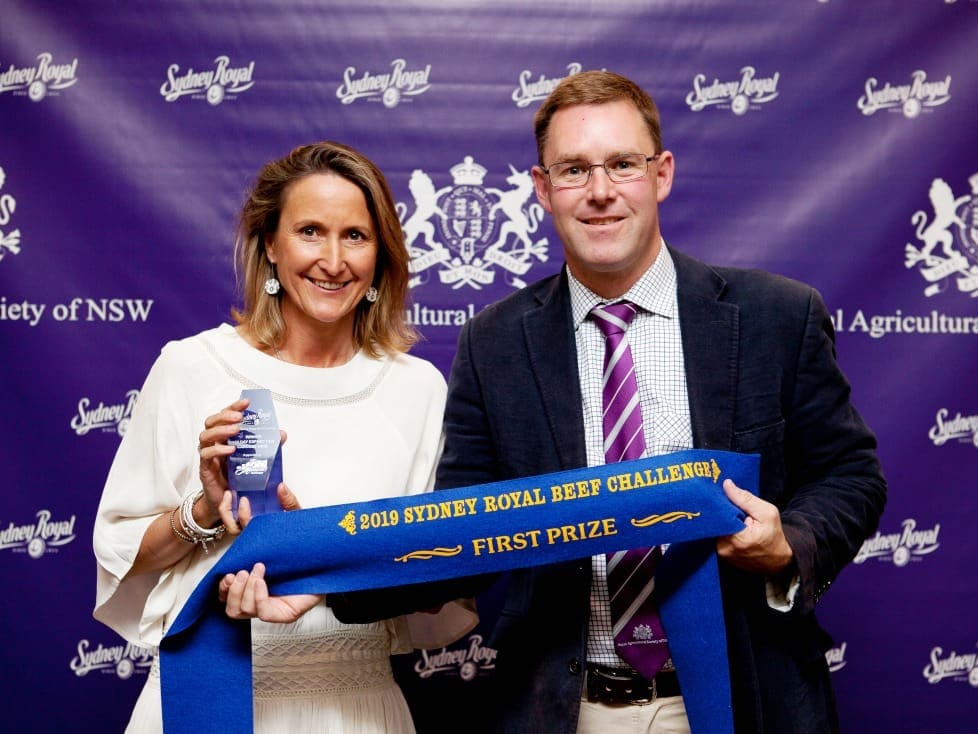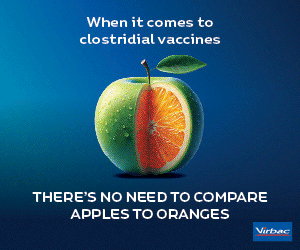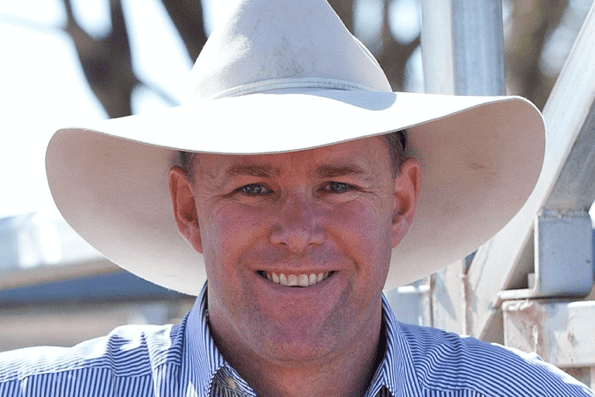
Wendy Mayne (Texas Angus) and Alastair Rayner RAS of NSW Cattle Committee
Genetics editor Alastair Rayner has served as a Sydney Royal Easter Show RAS Councillor for the past 15 years. In this week’s genetics review, he reflects on the importance of relationship-building between seedstock and commercial cattle producers and the broader community – a fundamental role played by the Royal Easter Show, and other ‘Royals’ around Australia.
IN any commercially-focused beef production program, the decision to select new bulls carries long-term implications.
Around 87 percent of the genetic makeup of the current calf crop in any commercial herd is influenced by the last three generations of sires. This makes it essential not only to assess a sire’s genetic suitability but also to physically inspect the bull for structural soundness, temperament, and suitability to the herd.
Importantly, making the effort to inspect bulls in person also creates a valuable opportunity: building relationships with breeders. The trust and understanding that grows through these interactions is often seen by both breeders and commercial producers as equally valuable – if not more valuable – than the individual bull selection. These relationships support better decision-making and lay the foundations for long-term continuity and confidence.
Trust is as important in beef production as genetic selection. It’s built through observation, respect, and understanding, qualities that matter not just in choosing a sire, but across the broader industry. While producers place trust in the sires and breeders they select, the industry itself also needs to earn trust from the wider community.
Recent research reported in Beef Central highlighted that 39 percent of cattle producers feel unsupported by the general public. Described as the “vulnerable majority,” this group feels a lack of support from the broader community, a perception that may not entirely reflect public sentiment.
This week, the two-hundred-and-second Sydney Royal Easter Show attracted close to 250,000 visitors in its first four days, including stud beef and commercial cattle judging which finished yesterday.

Animals attract people
While the Show celebrates excellence across agriculture, animals – and particularly cattle – are consistently rated by attendees as the top reason for attending. The RAS of NSW gathers annual feedback, and year after year, the public’s interest in livestock remains strong.
Many Australians have little personal connection to farms or agriculture, but this doesn’t mean they lack interest. Just as producers form opinions of sires by what they see, hear, and experience, so too does the public when they meet producers and observe animals up close.
During the Show, people asked about trade tariffs on beef, the impacts of floods in Queensland, and the drought in Victoria, demonstrating curiosity and compassion.
It’s easy to assume the public is indifferent. But during the four days of beef judging, many people stopped to talk with producers, ask questions, and observe cattle closely.
These moments, like the conversations producers have with breeders, deepen understanding and build trust. While most people may not grasp the technicalities of beef production, they walk away with a personal connection, seeing first-hand the pride, care, and commitment of those who raise cattle. These impressions last longer than any social media campaign.
Move from telling our story to demonstrating shared values
At the recent NTCA Conference in Darwin, advertising strategist Adam Ferrier encouraged producers to “Move from telling our story to demonstrating shared values.” This is a powerful reminder that actions carry more weight than words.
In sire selection, a breeder’s claims can carry less weight than seeing the cattle and assessing them first-hand. The same principle applies when engaging the public, credibility is earned through experience, not just messaging.
Adam Ferrier also urged producers to “make the unfamiliar familiar” and to “be as famous as possible. Use your distinctive assets. Use the hat. Clearly communicate your value.”
This advice applies not just to the industry broadly, but to seedstock producers as well. Building familiarity through in-person experiences is one of the most effective ways to earn trust.
Critics of agricultural shows, such as consultant Phil Holmes writing in Beef Central, have dismissed them as irrelevant to profitable beef production. Phil Holmes once wrote on this platform: “Avoid shows like the plague… All of this activity is errant nonsense… I have yet to find one of this mob who can quantify what a Champion ribbon at the Snake Gully Show will do for my bottom line.”
Perhaps this holds true if we judge shows solely by genetic improvement metrics. But if we view them through the lens of social license, of building understanding and public support, their value becomes clearer.
 At a time when public perception can influence regulation, investment, and trust, these interactions matter. They help buffer the industry against negative campaigns and reinforce positive, personal experiences with agriculture.
At a time when public perception can influence regulation, investment, and trust, these interactions matter. They help buffer the industry against negative campaigns and reinforce positive, personal experiences with agriculture.
Trust, whether in a breeder or an industry, is not built through hashtags or headlines. It’s earned, quietly and consistently, by showing up, opening the gates, and creating space for conversation.
As we continue to push for innovation and data-driven decision-making, we must also remember to showcase our credibility. In this light, agricultural shows, field days, and community engagement are not old-fashioned – they are essential to the long-term sustainability of our industry.
 Alastair Rayner is the General Manager of Extension & Operations with Cibo Labs and Principal of RaynerAg. Alastair has over 28 years’ experience advising beef producers & graziers across Australia. He can be contacted here or through his website www.raynerag.com.au
Alastair Rayner is the General Manager of Extension & Operations with Cibo Labs and Principal of RaynerAg. Alastair has over 28 years’ experience advising beef producers & graziers across Australia. He can be contacted here or through his website www.raynerag.com.au

Agreed, particularly important re public perception, as I have often stated in judging Best Maintained teams “the public walking through the sheds and watching judging see this as the industry”. There will always be breeds and breeders who are tantalised by the show ring, however show societies will also need to keep showing as a value proposition because as you quote the great man PH, they are less relevant in genetic improvement or profitability. In over 15 years of reviewing viability of a number of seed stock enterprises, I can identify studs that would have been far better serviced by having made alternate business decisions around showing.
My other observation is it remains important for shows to continue to educate throughout the supply chain, many royal shows continue to achieve this through their own efforts and in collaboration. For consumers the spectacle of showing in concert with demonstrating the red meat industry’s environmental, welfare and nutritional credentials benefits the industry greatly as your article attests. CT
Great article Al. I think one of the most under rated platforms these shows also provide is the opportunity for young people to develop confidence in assessing livestock, articulating their views, public speaking, decision making, responsibility, application of learnings.. the list goes on. I have had a lifelong dream to judge at Sydney Royal, this year achieving that for the third time, which is a testament to the skills, network, learning and opportunity shows provide younger people… even for folk born in the city like me. Keep fighting the good fight. JP